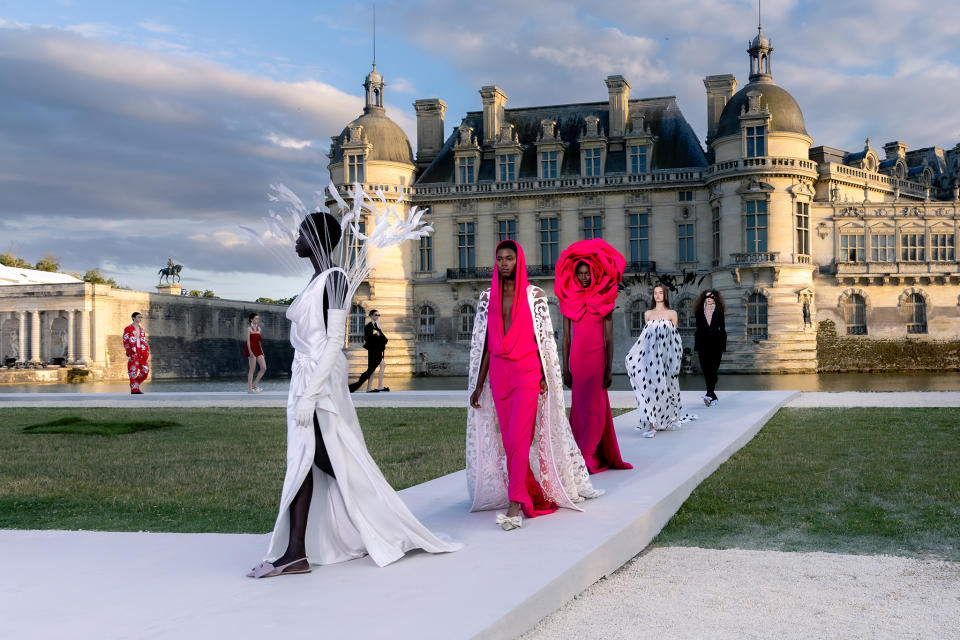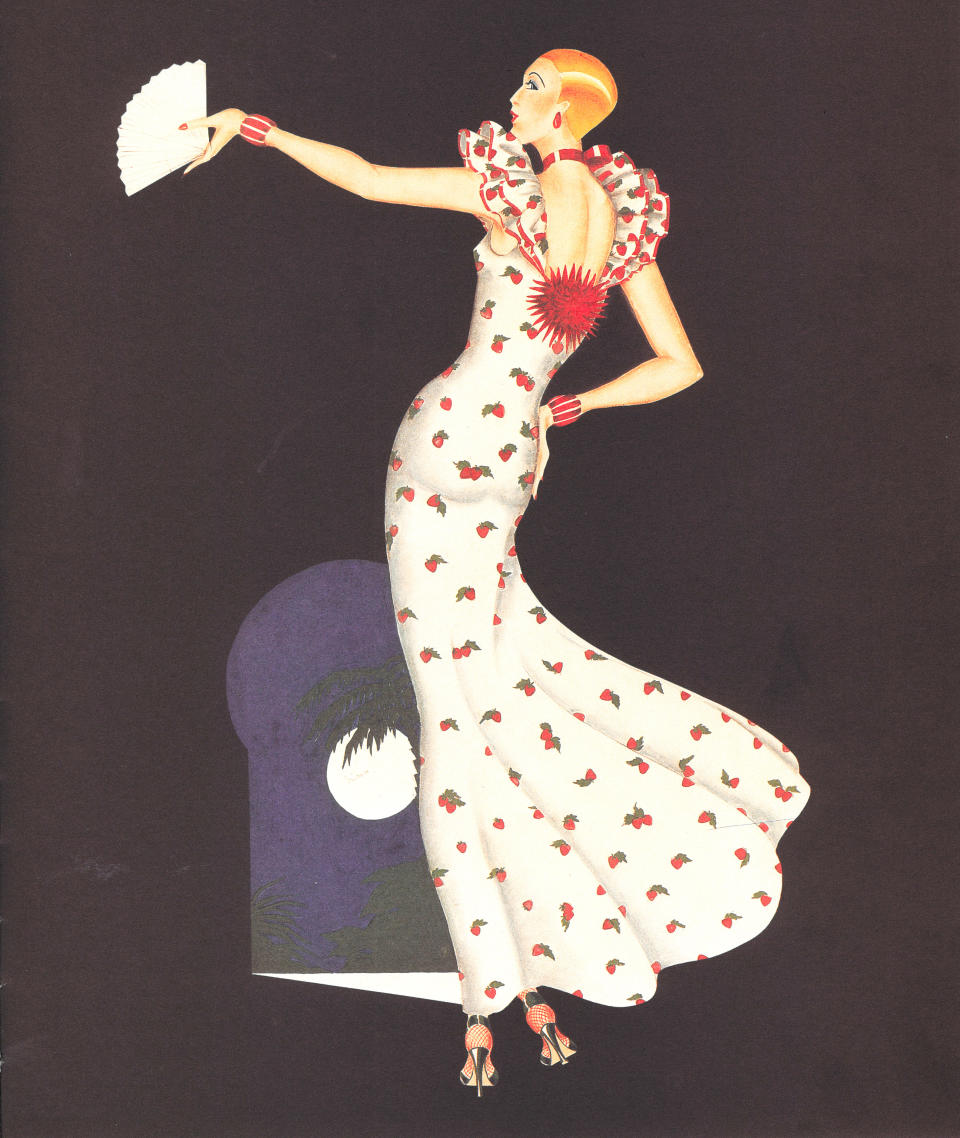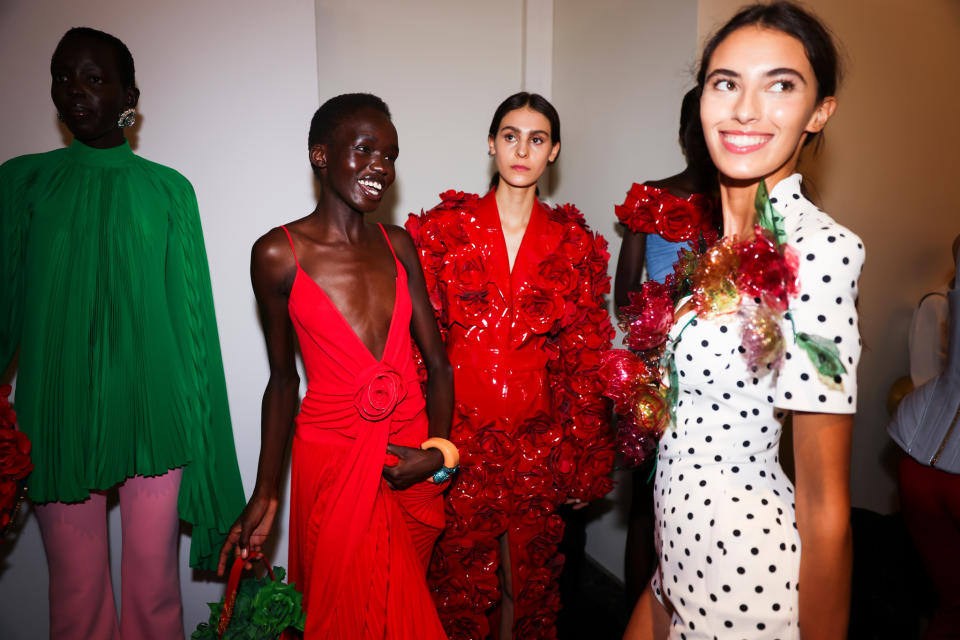CEO Talks: Mayhoola’s Rachid Mohamed Rachid
- Oops!Something went wrong.Please try again later.

Add Mayhoola’s Rachid Mohamed Rachid to the list of accomplished, high-profile luxury executives who got their start in fast-moving consumer goods — and quickly learned that the marketing approach is vastly different.
The longtime Unilever executive had something of a “eureka” moment in one of his early meetings with Valentino, which Qatar-based Mayhoola acquired in 2012, becoming a new player in the luxury landscape.
More from WWD
Valentino Sponsors Exhibit on Italian Contemporary Painting at Triennale Milano
A Peek Into Usher's Valentino Collab for Paris Fashion Week Concert, Front Row Looks
An executive from the Roman house was boasting to Rachid about his dress shoes, which puzzled the Egyptian businessman, who had spent most of his career in food and beverages.
“I was not a fashion guy at the time, so I asked, ‘what is so special about the shoes?'” Rachid recalled, expressing fresh puzzlement when he was told it was because the shoelaces were cashmere, inquiring, “‘What is the benefit of it? Does it make your feet warmer?'”
The Valentino executive was more than happy to explain the “unbelievable” sensation when tying his shoes each morning.
“That was really an eye opener,” Rachid recalled. “This is not something that you would think about in a company like Unilever or Procter & Gamble because it’s something people don’t need. But you’re trying to touch on a level of emotion which is beyond the normal one. In luxury, it’s more emotional than functional.”
Rachid caught on fast to the ways of the luxury business: Mayhoola has tripled the size of Balmain to around 300 million euros since acquiring it in 2016, and Valentino fourfold to more than 1.2 billion euros, attracting the attention of Kering, which recently took a 30 percent stake in the Roman fashion house, with the option to buy more.

“There was a vision from the beginning that we wanted to establish Valentino as a maison de couture, which is very much based on our haute couture capabilities historically, and stay very much at the ultimate luxury positioning that we want to have,” the executive said in an interview at Valentino’s showrooms on the Place Vendôme. “And I think that was what was achieved. And the agreement that we have with Kering is a very strong validation of that.”
Rachid made it clear Mayhoola is in luxury for the long haul, and its portfolio is bound to grow beyond Valentino, Balmain, Pal Zileri and Beymen, the luxury retailer based in Istanbul.
“In the long term, what we want to achieve with Mayhoola is to be a powerhouse investing in luxury,” he said, citing a wish to build “a bigger portfolio of brands and bigger portfolio of financial investments. We knew from the beginning that in order to continue to flourish in the luxury business, you cannot just depend on one company or on one brand.”
Rachid disclosed that Mayhoola had been exploring an initial public offering as a way to bolster governance, raise capital for M&A, and create incentive systems like share options for its management teams.
When Mayhoola entered discussions with Kering, it was able to “emulate the same advantages” and “to maintain the management of the company for a period of time to accelerate the value creation there and to continue the route that we set for Valentino.”
But ultimately, “we want to be incorporated with a bigger investment platform in luxury.”
Kering has an option to buy 100 percent of Valentino’s capital by 2028, as reported, while Mayhoola has an option to become “one of the important shareholders in Kering” with a possibility to go to 10 percent, according to Rachid.
“In addition to that, we agreed with Kering group that we are going to explore investments in areas beyond fashion, but in luxury, so that could cover hospitality, food and beverage or other areas,” he disclosed.
He described the above as a framework to be implemented over the next five years following the closing of the deal, which is expected before the end of the year.
“We definitely found in Kering and its leadership a like-minded institution,” he said, praising the leadership and vision of its chairman and chief executive officer François-Henri Pinault.
A calm, articulate executive with a professorial bent, Rachid has clocked a variety of experience in business, and government, challenging himself to make an important switch every five years or so.
His first business was as the bottler of Coca-Cola in Egypt, when the soft drink maker was considered “the ultimate brand in the world of marketing.”
Later in the ’80s, Rachid entered into a joint venture with Unilever, starting out with Lipton tea and other beverages, and ultimately expanding into personal and household products, plus perfumes, at one point running 17 factories in his homeland.
“It was a huge success story over a period of 20 years,” so much so that the chairman of Unilever at the time asked Rachid to join him as an executive director as the-then Anglo-Dutch giant work was embarking on an acquisition spree. “In one week, he bought three companies: Best Foods, Ben & Jerry’s ice cream and Slim-Fast.”
Rachid said he was initially reluctant to make such a radical shift from entrepreneurship, but he moved to London and worked for the multinational corporation for four years, part of an executive team that ran a food business worth some $35 billion.
“I felt that my fate in life is that every few years, you have a new page to fill,” he said with a smile. “So I turned the page.”
In 2004, another unexpected blank page arrived when the government of Egypt invited him to lead the country’s economic reform and liberalization. He acted as Minister of Trade and Industry of Egypt until 2011, playing a significant role in increasing imports, attracting foreign investments and fueling high rates of economic growth and employment.
He fled the country after the 25 January Revolution of that year, established himself in Qatar and sold his 40 percent stake in the Unilever joint venture, which then boasted a market capitalization of about 2 billion euros.
“At that time I was looking for what is the next page, and what I wanted seriously was to go back into business. And it was very clear that it could not be consumer goods again,” he said.
(That said, in 2021, Rachid was among investors when CVC Capital Partners agreed to buy Unilever’s tea division, which includes Lipton, for $4.5 billion.)
Ultimately, he set his sights on luxury, having observed the sector’s potential amid globalization, and the emergence of markets like China. Rachid noted that in his capacity as a government official he had been involved in an Egyptian cotton project with Altagamma in Italy, and another initiative with the French government involving an exchange of artisanal fashion talents between Cairo and Paris.
Thanks to those dalliances with luxury, he got to know many executives from the business, including from Valentino and its private equity owner.
Rachid established what was then called Mayhoola for Investments along with a number of private investors, including Qatar’s royal family. “We keep the shareholding very confidential,” he stressed.
In 2012, Mayhoola acquired Valentino Fashion Group SpA for an estimated 700 million euros, purchasing it from Red & Black Lux Sarl, a company indirectly controlled by the Permira Funds in partnership with the Marzotto family.
Rachid would later found the Alsara Investment Group, and the investment company Bidayat specializing in “creative entrepreneurship in the Mediterranean region,” whose shareholdings also remain confidential.
He said those entities were created for investments in start-ups and small companies, recognizing “it’s very difficult to manage large companies and small companies at the same time.”
Alsara Strategic Investments, which controls Bidayat, includes the brands Akoni, which produces eyewear for Valentino and Balmain; puffer jacket maker Khrisjoy; design venture Fromm; jewelry brand Azza Fahmy; Egypt-based handbags label Okhtein; Flyroom, and the IP of Walter Albini, with the goal to revive the dormant Italian fashion brand.

Rachid is also the chairman of Valentino and the chairman of Balmain.
During a wide-ranging conversation, Rachid shared his views on the luxury business, mused on his leadership style and the silver lining in failures.
WWD: How has your time at Coca-Cola and Unilever shaped you?
R.M.R.: These were some of the best schools of marketing and management in the world. If you go and study at Harvard, which I did, and other places, they just take case studies from there and tell you how they did it. If you want to teach luxury in a business school today, you have to go to the luxury companies to tell you what to say. It’s more the practice than theory.
When I was at Unilever, we were spending 50 percent of our time in education — educating ourselves and educating others in the company via mentorships. Even the best football players, they need trainers. Why should executives think that they cannot get better?
WWD: Why did you switch careers and sectors so many times?
R.M.R.: I always convinced myself — and now I’m convincing young people — that every four or five years, we have to find the courage to do something a little bit different. There is something valuable in going from one comfort zone to another challenging area in your life.
I like challenges. Creating something new is always very exciting for me. The satisfaction I get from creating a new brand, or a new market, or a new success comes irrelevant of size. So whether it’s a billion dollars or its $5 million, I get the same satisfaction.
WWD: Was it hard to switch from fast-moving consumer goods to luxury?
R.M.R.: From my first meetings with Valentino, I saw very clearly that the marketing rules are upside down: In consumer goods, we were always taught to say, “Let’s identify the needs of the people and provide it to them.” That’s how you can create success. In luxury, you don’t care about what people need: you tell them what they need, and create desire around it.
Essentially they don’t need your products, but you are convincing them they need them because they will feel better.…You have to be able to heighten that emotional value to a very high extreme.
WWD: Most luxury brands are managed by European groups. How does Mayhoola differ in its approach?
R.M.R.: My goal is not to get into the day-to-day management of the brands or the business. It’s all about the vision, getting the best people that we can get in terms of leadership, and creating the right environment for them to operate. That’s what Mayhoola is providing for for the brands.
WWD: Is Mayhoola satisfied with the progress at your other fashion and retail propertes?
R.M.R.: Balmain is growing in a very healthy way. We have a very successful and very dynamic designer in Olivier Rousteing, who has created a very clear and distinctive direction and character for the brand.
Pal Zileri is a different story, as we had the challenge that all the formal menswear companies had. But we are taking advantage of the reality that tailoring is picking up again. After the pandemic, people are going back to suits and going back to a mix between formal and casual.
As for Beymen, when we bought the business five years ago, it was losing money. Last year, we made more than 200 million euros of profit, and it has 70 percent of the luxury market in Turkey, led by a fantastic team and an amazing lady, our CEO Elif Çapçı.

WWD: What are the pros and cons of being a smaller group in the shadow of giants like LVMH Moët Hennessy Louis Vuitton, Richemont and Kering?
R.M.R.: Being smaller gives you the opportunity to act faster, and to be much more aggressive in the moves that you make. But obviously, it is very clear from the evolution of the luxury in the last few years that big groups have more and more advantages. And I think this is also one of the things that we aspire to have, now being associated with Kering.
Having the advantage of being small in terms of flexibility and speed, if you can combine that also with the size advantages, including the capability of having the best real estate, having critical mass in order to negotiate better deals in terms of support and, and visibility — that’s what we are aiming for.
WWD: What’s your view on the consolidation that’s been sweeping the fashion industry?
R.M.R.: The biggest factor that impacted luxury in the last two or three decades now is globalization. If we look back 25 years ago, the luxury business was basically in Western Europe, the United States and Japan. Today, we know China and Chinese consumers became number-one in luxury consumption even before the pandemic. They came from zero to almost 40 percent. And now we are talking about new frontiers in India, Latin America and the Middle East.
If you want to serve the whole globe, you need a very substantial retail organization, and very substantial distribution and sales supported by a huge backing of advertisement, visibility and communication, to be able to sustain this. And to manage the challenges of technology today, you need a much higher infrastructure and bear much higher fixed cost. That is why people consolidate. And I believe this will continue.
WWD: Some luxury analysts have downgraded the sector over softening trends in the U.S. and China. What’s your assessment?
R.M.R.: My long-term view on luxury is very positive, and my medium-term view is also positive. But 2023 is going to be a challenging year.
Bain & Co. has forecast growth for the industry will be around 10 percent. It’s going to be worse than that, that’s for sure. The market is much softer in the U.S. than people expected, and department stores are under pressure. China is not recovering at the speed people expected after the opening up from the pandemic. And Europe, despite the reality that there are still a lot of tourists coming in, they have shifted their spending toward experiences.
Airlines, hotels and restaurants have all increased prices…so people have less money to spend on luxury goods.
WWD: Do you see any limit to how expensive and how exclusive luxury is becoming?
R.M.R.: Look at what’s happening in the art world. Ten years ago, nobody would have believed a painting or sculpture would go to levels of 100 million euros, 200 million euros, and that is because of exclusivity.
You cannot just slap luxury on anything: If you start losing the exclusivity, it is not luxury anymore. It is a balance between how much you can grow and how much you can increase prices, because exclusivity by nature means that less and less people are able to get it.
WWD: How much do economic indicators guide your decision-making, and how much instinct?
R.M.R.: I worked in government, so I worked with economists: They’re perfectly able to explain to you what happened in the past, but they have no clue what will happen in the future.
For that reason, you need to rely on your gut, and that’s based more on your experience, knowledge and network. I’ve learned in my life that guts come from being close to the consumer, close the market, and also seeing the big picture. You will learn a lot if you go to the store, and if you walk on the street and if you sit on a coffee shop — as much as reading the best economic reports. You need have to have both inputs.
WWD: What do you appreciate the most about the luxury and fashion space?
R.M.R.: You go to the fashion shows, so you know people are waiting for somebody to tell them what they should like, because they don’t know what it is that are waiting for. It was really very surprising to me that works, and it’s not just a onetime phenomenon. It works all the time.
We have seen our share of street-fashion surprises. We saw that people were willing to pay hundreds and thousands of dollars for sneakers. Ten years ago, nobody would have expected that to happen because the trends have changed.
WWD: Do you have any business mantras?
R.M.R.: I know for sure that I need to learn something every day. It is very important that you admit that you your knowledge is limited, and you admit that you have to learn. I did many, many projects in my life, and I can assure you that the number of projects I’ve failed at are bigger than the ones I succeeded in. And the reality was that my best learning came from the failures and not the successes.
WWD: How would you describe your leadership style?
R.M.R.: I like to be engaged. I like one-to-one discussions. I like to be aware of the capabilities, the weakness and the strengths of the people around me. And I would like to be as inspiring as I can for those people.
Best of WWD

